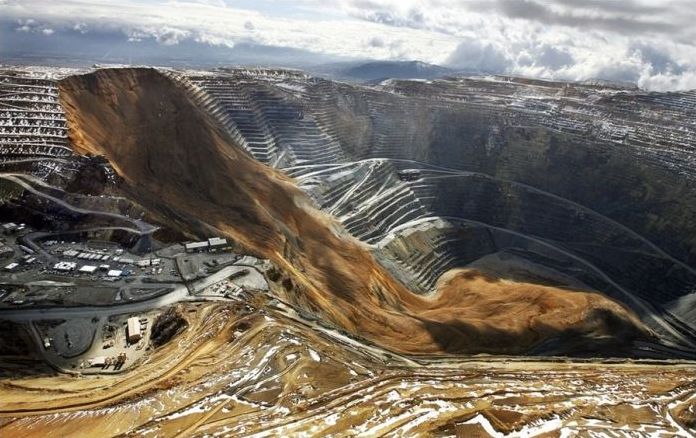|
|
Massive Landslide In Kennecott Copper Bingham Canyon Mine, Oquirrh Mountains, Salt Lake City, Utah, United States
|
Minerals, in the form of copper ore, were first discovered in Bingham Canyon in 1848 by two brothers, Sanford and Thomas Bingham, sons of Erastus Bingham, Mormon pioneers of September 1847, who grazed their family's and other's cattle and horses there. They reported their find to their leader, Brigham Young, who advised against pursuing mining operations because the survival and establishment of settlements was of paramount importance at that time. The brothers applied themselves to that purpose as directed and did not stake a claim. In 1850, the Bingham family went to settle what is now Weber County, leaving the canyon still today known by their name.
It was not until 1863 that extraction of ore began and the potential of the canyon's mineral resources began to be widely recognized. At first, mining was difficult due to the area's rugged terrain, but a railroad reached the canyon in 1873, prompting greatly increased mining activity and accompanying settlement. The canyon's nineteenth-century mines were relatively small, however, and it was not until 1898 that plans for very large-scale exploitation of the canyon's ore bodies began to develop. That year, Samuel Newhouse and Thomas Weir formed the Boston Consolidated Mining Company, intending to increase mine development in the canyon.
A more significant development took place in 1903, when Daniel C. Jackling and Enos A. Wall organized the Utah Copper Company. Utah Copper immediately began construction of a pilot mill at Copperton, just beyond the mouth of the canyon, and the company actually started mining in 1906. The success of Utah Copper in mining the huge but low-grade porphyry copper type orebody at Bingham Canyon revolutionized the copper industry, and set the pattern for the large open-pit porphyry copper mines that today dominate the copper industry worldwide. Utah Copper and Boston Consolidated merged in 1910. The Kennecott Copper Corporation, established in 1903 to operate mines in Kennecott, Alaska, purchased a financial interest in Utah Copper in 1915 and fully acquired the company in 1936.
Bingham's Canyon mine expanded rapidly, and by the 1920s the region was a beehive of activity. Some 15,000 people of widely-varying ethnicity lived in the canyon, in large residential communities constructed on the steep canyon walls. The population declined rapidly as mining techniques improved, however, and several of the mining camps began to be swallowed up by the ever-expanding mine. By 1980, when Lark was dismantled, only Copperton, at the mouth of Bingham Canyon and with a population of 800, remained. For years, the largest open-pit mine in the world, it is still among the world's largest open-pit mines. Work to expand the mine 600 feet (180 m) east began in 2005, continuing to increase its size, growth, and capabilities.
|
|









